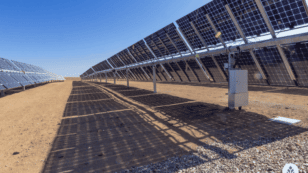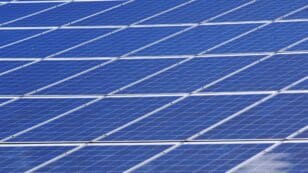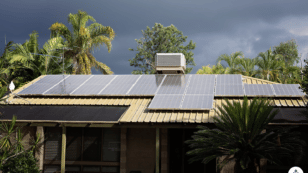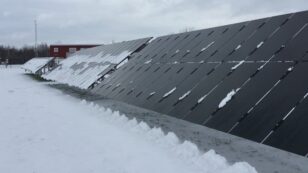
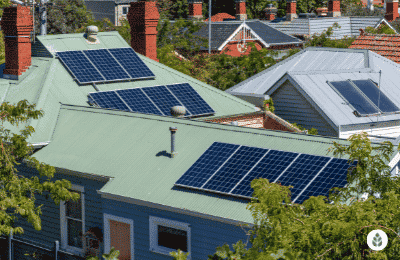
SRECs: Solar Renewable Energy Credits (How to Sell Them in 2024)
In this guide, you’ll learn:
- How much money you can save with different solar system sizes
- Which solar financing options lead to the greatest ROI
- Which solar providers can help you save the most
Each product and or company featured here has been independently selected by the writer. You can learn more about our review methodology here. If you make a purchase using the links included, we may earn commission.
Going solar can save you thousands of dollars over time, while also helping protect the environment. But these benefits come with a significant up-front cost.
Thankfully, there are a number of solar incentives and rebates available in most states. Some of the most important are solar renewable energy credits, or SRECs for short. These credits allow you to earn money for the solar power your home produces.
In this article, we’ll explain exactly what SRECs are, which states have open SREC programs, how much SRECs are worth and how to sell them for a profit. We’ll also explain how to estimate how many SRECs your solar energy system will produce.
What Are Solar Renewable Energy Credits (SRECs)?
SRECs are credits you earn for producing clean energy, typically by installing photovoltaic solar panels on your home. You can earn these credits regardless of whether you use the power you generate for your own home or send it to the electric grid through net metering.
A typical home solar energy system should produce between seven and nine SRECs per year. You can then sell them on the local SREC market. The price per credit can vary quite a bit, and often change with demand. But the average in America usually hovers between $30 and $60 – though it can be much higher, up to $250 or more, in some areas.
We’ll dive deeper into what determines the value of an SREC in a later section.

Blue Raven Solar

Regional Service
Average cost
Pros
- Industry-leading in-house financing
- Competitive pricing
- Excellent reputation
Cons
- Doesn't offer solar batteries (coming 2022)

Blue Raven Solar

Regional Service
Average cost
Pros
- Industry-leading in-house financing
- Competitive pricing
- Excellent reputation
Cons
- Doesn't offer solar batteries (coming 2022)
Why Do SRECs Exist?
SRECs originated as a way to give incentives for producing clean energy.
Many states have renewable portfolio standards goals, which set forth a target for how much of its electricity should come from renewable energy sources. Utility companies are then judged by how much of their electricity comes from things like solar power, wind power, biomass, and hydroelectric power.
Many states also have requirements for individual sources of clean energy. For example, a solar carve-out might guarantee that 10% of the state’s clean energy must come from solar equipment.
If utility companies don’t meet their goal, they may get penalized with a fine. So if a utility company can’t produce enough clean energy itself, it often can buy SRECs from property owners who produce their own solar power.
This often means that the more aggressive a state’s renewable portfolio standards goals are, the more valuable the SRECs become.
Current States With SREC Programs
In general, SREC programs only exist in states with defined RPS goals. However, this isn’t always the case. Some states have voluntary goals that don’t demand an SREC market and some states don’t need SRECs to meet their goals.
Although 30 states have active RPS goals, only 12 (plus Washington, D.C.) have SREC programs. Below is a list of all of the states and territories in the country that currently have an open SREC market:
- Delaware
- Illinois
- Indiana
- Kentucky
- Maryland
- Massachusetts
- Michigan
- New Jersey
- Ohio
- Pennsylvania
- Virginia
- Washington, D.C.
- West Virginia
More states could soon be joining this list. According to the Energy Information Administration (EIA), Nebraska, North Carolina and Oregon most recently adopted RPS goals that call for 100% renewable energy production by 2050. It’s possible that these states will start SREC programs in an effort to reach those goals. As of this writing, 15 states total have 100% RPS goals, so SREC programs could become more prevalent in the future in other areas as well. These states include the following:
- California
- Colorado
- Connecticut
- Maine
- Minnesota
- Nevada
- New Mexico
- North Carolina
- Oregon
- Rhode Island
- Washington
- Washington, D.C.
It’s also worth mentioning that some states are transitioning to different structures, including transitional renewable energy credits, commonly referred to as TRECs. The primary difference between TRECs and SRECs is that TRECs are sold at a fixed price, while SRECs are based on supply and demand. New Jersey is a good example of a state moving to a TREC program.
How Much Are SRECs Worth?
While the average SREC in the U.S. is worth between $30 and $60, the value depends on several factors, including the following:
- RPS goals in the state
- Supply and demand
- Alternatives to meeting RPS goals
- The age of your SREC
We’ll discuss each of these factors below and explain how they affect the local value of an SREC.
Your State’s RPS Goals
First and foremost, the demand for SRECs depends, on some level, on your state’s RPS goals. The more aggressive the RPS goal is, the more likely in-state electric providers will need to purchase SRECs to meet the standards set forth by the RPS goals.
For example, if your state has an aggressive RPS goal that mandates 100% of the state’s energy to come from clean energy sources in a short amount of time, then companies will likely scramble to reach that production goal. One of the most convenient — and most affordable — ways of doing that is to buy SRECs from solar customers.
Aggressive goals typically lead to a high demand for credits, which tends to push the value per credit up.
Supply and Demand
SREC prices also depend on the volume of solar equipment installed in your state. If your state has a large number of homes with solar power, the price paid for a SREC likely goes down.
The ratio of renewable energy customers to those who rely on fossil fuel-burning utility companies also matters. If a large number of homes are powered by electricity from coal plants, that means that a larger amount of clean energy would be needed to hit RPS goals. So the value of a SREC would go up.
However, since the supply and demand model for SRECs is so complicated, the credit value doesn’t typically follow any clear pattern. Things like changes in energy demands, changes to the federal solar income tax credit, new state tax credits, financial incentives or rebate programs, existing incentives expiring or being discontinued and more can all affect the new supply of solar and, therefore, the supply of SRECs positively or negatively.
As that supply changes randomly, so too does the demand and the value of SRECs.
Alternatives to meeting RPS goals
If utility companies don’t meet their clean energy goals, they typically have to pay a fine – also known as an “Alternative Compliance Payment.” States set their ACP at a fixed price that gets charged per megawatt under the goal.
The ACP is an important factor in determining the value of an SREC because it sets a cap on what companies are willing to buy credits for. The local SREC value will never rise above the ACP because, if it did, the energy company would just pay the ACP instead of offsetting their fossil fuel consumption or CO2 production with credits.
The ACP varies by state based on the specific RPS goals, how aggressive they are and what the state deems a reasonable fine for not meeting them.
The age of your SREC
Once you generate a SREC from your home’s solar energy production, you don’t have to sell it right away. However, it can lose value over time. In most states, SRECs expire in a maximum of five years, with some states having a three-year holding cap for credits. After that time, you lose the credit and don’t get any compensation.
SRECs are generally worth the most when they are new. If you generated a credit in 2024 and wait until 2025 to sell it, you’ll likely see a lower price for the “vintage 2024” credit than you would for one generated and sold within a single year.
How Many SRECs Will Your Solar System Produce?
Determining how many SRECs your solar system will generate can be a complicated process because there are quite a few factors that can affect your system’s solar production. These include:
- The energy efficiency of your panels
- The degradation rate and age of your system
- The direction your roof faces
- The pitch of your roof
- Shading on your property
- Your geographical location
- Local weather conditions
You can read more about the factors that have an impact on energy generation in our guide to sizing your solar system for your home.
Generally speaking, you can expect to earn between 1 and 1.2 SRECs per year per kW installed. That means the typical 9 kW system will produce between 9,000 and 10,800 kWh of solar electricity annually, which would be between 9 and 10.8 SRECs (rounded down to 10).
Based on average pricing, this means you can expect to earn between $270 and $600 per year from SRECs generated by your home’s solar panels.
However, a solar array that is larger or smaller than average will generate more or fewer SRECs. The table below includes some average generation rates and SREC production numbers that you can use as a guide.
| Solar Panel System Size | Avg Annual Power Production | Avg Annual SRECs Earned |
| 5 kW | 5,000–6,000 kW | 5–6 |
| 6 kW | 6,000–7,200 kW | 6–7 |
| 7 kW | 7,000–8,400 kW | 7–8 |
| 8 kW | 8,000–9,600 kW | 8–9 |
| 9 kW | 9,000–10,800 kW | 9–10 |
| 10 kW | 10,000–12,000 kW | 10–12 |
| 11 kW | 11,000–13,200 kW | 11–13 |
| 12 kW | 12,000–14,400 kW | 12–14 |
How Can You Sell Your SRECs?
The process of selling your SRECs will depend on where you live and the systems set up in your state. You can follow the general steps below, but be sure to do some state-specific research to see if the process differs in your area.
Step 1: Register with your state’s SREC program
After your photovoltaic (PV) solar energy system is installed on your home, you’ll need to register with your state’s SREC tracking system. The specific system used will vary from state to state, but you can always check the Database of State Incentives for Renewables & Efficiency for information on your state’s program or do a simple search online. Just be sure only to register on official .gov sites. In many cases, your solar installation company will register you automatically.
Step 2: Generate solar power from your home
Next, you’ll need to wait until you have earned at least one SREC from the solar power system installed at your home. For the typical system, this should take two to three months.
Step 3: Find a buyer for your SREC
The next step is the most complicated, as the process can vary quite a lot depending on your state. Most homeowners in SREC states can find brokers or aggregators online that can sell their SRECs for them. Some popular examples include SRECTrade and SolSystems. You can also sign up to post on the GATS (Generation Attribute Tracking System) bulletin in most SREC states and post your credits for sale there. You can also use this bulletin to get a sense of the supply and demand in your area.
Step 4: Negotiate a selling price
Once you find a buyer, you may need to negotiate a sale price based on supply and demand. If you’re working with a broker, they can typically help you determine the highest fair market price you can charge.
Step 5: Complete the sale
Finally, you complete the sale through your state’s SREC transfer program. Whether you’re working with a broker or a site that helps coordinate SREC transfers, this process should be relatively straightforward.
There’s no ideal time to sell SRECs because the price fluctuates regularly. Since most states have RPS compliance periods in the late spring or early summer, the demand is usually highest in April and May when companies need to prove they have met the RPS goals.
However, we recommend keeping an eye on SREC value throughout the year and selling when the going price is the highest. Ideally, you want to sell whenever the value approaches the ACP, although timing the credit sale can be tricky. Overall, just make sure you sell your SRECs before they expire, even if that means selling at a low price point.
What Happens to SRECs If You Move?
In most cases, a homeowner who is moving agrees to transfer the existing SRECs their solar power system has generated to the new homebuyer, along with ownership of the system. Some sellers even use this as a means of getting more money for their homes, along with the property value added by the PV system itself. However, SREC ownership is independent of system ownership, so the transfer is not always guaranteed.
If you’re selling your home, decide whether you want the opportunity to sell your SRECs in the future or use them as an incentive for the buyer to purchase your home. Just be sure to be clear with your agent, attorney and buyer what you intend to do with the credits. If you keep them, the solar array could continue to provide payouts for years even though you no longer own the system.
If you’re purchasing a home that has a solar array installed in an SREC state, make sure you ask about the energy credits. Regardless of what the seller intends to do, it’s important that you know if you’ll be taking ownership of the credits and be able to sell them later or if the seller is retaining ownership.
Since signing up for your state’s SREC program and selling the credits can be complicated, we recommend working with a reputable and experienced solar company that will handle the paperwork for you and guide you to any resources you need to sell your credits for a profit. You can use the tool below to get connected to a reliable installer that can walk you through the process and help you take advantage of other incentives as well.
The cost information presented in this article is derived from a comprehensive analysis, incorporating data from multiple industry sources. The average cost per watt per state was calculated based on figures from Consumer Affairs, Energy Sage, and Berkeley Lab’s Electricity Markets & Policy Department. Additionally, monthly energy consumption and the average monthly cost of electricity were sourced from the U.S. Energy Information Administration, ensuring a well-rounded and accurate representation of the information presented.
FAQs: Solar Renewable Energy Credits (SRECs)
SRECs are credits you earn for producing solar power with your home’s solar panels. A typical home solar panel set-up will earn between seven and nine SRECs per year. These SRECs can be sold for a profit, provided you live in a state with an open SREC market. Each SREC is typically worth between $30 and $60, though the value can change based on supply and demand.
The average value in the U.S. is between $30 and $60, but credits can be worth much more in some states. The value of an SREC depends on where you live, the supply and demand, your state’s Renewable Portfolio Standard goals and the monetary fine companies would have to pay if they don’t meet those goals.
Renewable energy credits (RECs) and solar renewable energy credits (SRECs) are very similar, and they function the same way. You earn credits for renewable energy production and can then sell them to companies that use them to meet clean energy standards. The only difference is that RECs can come from any renewable energy source, including wind, hydropower, biomass and more. SRECs, as the name implies, can only be generated with PV equipment.
Comparing authorized solar partners
-
- Industry-leading in-house financing
- Competitive pricing
- Excellent reputation
- Doesn't offer solar batteries (coming 2022)
A+Best Solar Financing2014Trina Solar, Canadian Solar, SolarEdge, Silfab, SunPower25-year manufacturer warranty; 10-year workmanship warranty, 2-year production guarantee
Having trouble deciding? Click below and use our process to receive multiple quotes instead:

 233k
233k  41k
41k  Subscribe
Subscribe 




